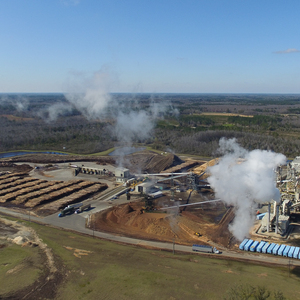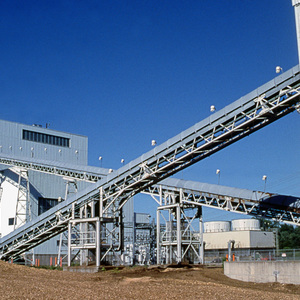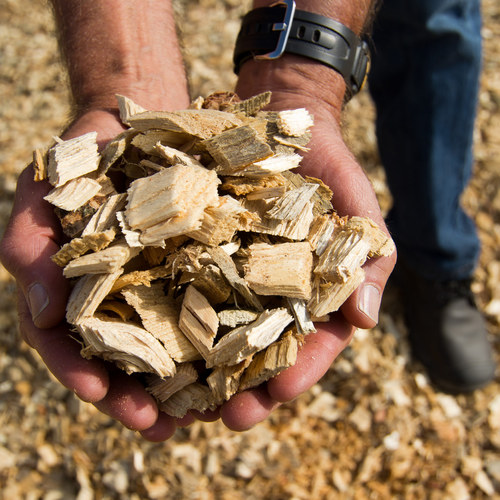
A push for wood-burning power plants has eased in the U.S., but the use of wood pellets to produce electricity is flourishing elsewhere and remains a serious environmental threat, an energy policy advocacy group warns.
Writing in the New York Review of Books, Mary S. Booth said the use of forest biomass as a replacement for coal is increasing the amount of CO2 in the atmosphere and amounts to a “parade of stupidity” that benefits the growing biomass industry financially.
Booth founded the Partnership for Policy Integrity in 2010. Its purpose, she says, is to provide reliable information on the environmental impact of burning forest products to produce electricity.
An industry that started out small with sawmills and paper manufacturers burning waste for heat and power has since mushroomed into a colossus, Booth says. The biomass and pellet industries are pulling in billions of dollars in renewable energy subsidies at the expense of the environment.
Burning wood to make electricity has proven to be expensive in the U.S., even with government subsidies. That has slowed momentum here. Incentives available in Europe however, have helped double wood consumption between 2000 and 2017. About 35% of total renewable energy in Europe is sourced from wood, with total wood consumption for energy now more than 400 million tons a year, Booth said.
Policymakers in Europe, the U.S., and elsewhere seem happy to consider biomass as a green substitute for coal, she says, while “scientists and activists are reacting with bewilderment and fury as entire forests are vaporized into the atmosphere in the name of renewable energy.”
The rising demand for wood pellets has led to increased wood harvests in less regulated forests, particularly in the southern U.S. and Canada. Forests in “less scrutinized” areas of Europe, including Slovakia, Ukraine, and Romania, also have seen heavier harvesting. Although wood pellets make up a fraction of the wood used for energy in Europe, the impacts have been “horrendous.”
“Clear cutting is never pretty, but there is something especially sickening about seeing a forest annihilated for supposedly green energy,” Booth says.
A single power plant in the United Kingdom has converted four of its six boilers to burn wood pellets and in a single year consumes wood equivalent to clearcutting 324 square miles of forest, Booth claims. Renewable energy subsidies to the Drax plant amount to about $1 billion a year.
Advocates of biomass power generation argue the resource is rightfully classified as renewable because new trees can take the place of trees harvested for fuel. The carbon that had been sequestered in harvested trees will again be taken up by new growth. Critics, however, point out that forests take decades to regrow while burning wood for fuel releases C02 immediately. Further, burning biomass emits more carbon dioxide than burning coal.
“Thus, far from being zero-carbon, the cumulative net emissions from burning forestry residues for fuel still speeds the transfer of forest carbon into the atmosphere, and the accumulated net impact of such emissions likewise speeds warming,” Booth says.
Booth and others make these arguments in a 28-minute film called “Burned: Are Trees the New Coal?” which you can see online here. It’s a sobering indictment of the industry’s assault on wetland forests of the southeast U.S. and accuses the industry of lying to the public for financial gain.
The pellet industry cries foul
The U.S. Industrial Pellet Association, a trade group, claims the film amounts to a hatchet job.
“The truth is that this film is not just unbalanced—it’s completely biased and dangerously wrong,” a statement at the group’s website claims in a lengthy rebuttal. “It paints a deeply inaccurate picture, basing its narrative on flawed assumptions about how forestry operates and how US forests over recent years and decades have performed.”
The association says the the film “falls into the normal pattern of anti-biomass campaigners” by failing to provide context and making factual errors.
Instead, the group recommends a film that extolls the environmental virtues of biomass called “The Biomass Sustainability Story.” You can watch that film here.
The group makes these arguments:
- Data from the U.S. Forest Service shows a net growth of forest inventories in the South, up a total of 108% since 1951.
- Wood harvested for pellets represent just 0.34% of total forest inventories.
- Because forests in the U.S. southeast are experiencing net growth, there is no time lag in carbon sequestration. The association calls this the “carbon debt fallacy.”
- Harvesting wood for pellets is not as much of a threat to forests as urbanization and conversation to agriculture. “Profits from bioenergy (and other sectors) actually help protect forests,” it says.
- Claims by Booth’s group about clearcuts in the South are misleading. Trees used for pellets are of “very low value.”
- The carbon released by burning wood (“biosphere” carbon) is different than the carbon released by burning fossil fuels (the group calls this “geologic” carbon).
Claims filed with SEC
Booth’s group ridiculed the host of the pellet industry film, a British environmentalist named Tony Juniper, and has filed a complaint with the Securities and Exchange Commission against Enviva, a major producer of wood pellets in the Southeast.
Booth said the 2016 complaint alleged the publicly traded company made misleading claims about carbon emissions. The group also requested new rule-making from the SEC that would require biomass producers and users to disclose greenhouse gas emissions “that are informative to investors and not materially misleading.” That request was filed by the Partnership for Policy Integrity and 27 other organizations, including a number of investment advisors.
“Companies manufacturing and selling biomass-based fuels and products often make dubious or unsubstantiated claims that the products reduce greenhouse gas (GHG) emissions,” the letter to the SEC reads. “The growth of these products and a surge of interest in investments that promise to reduce GHG emissions mean that such claims are likely to be material to an increasing number of investors.”
In an email this week, Booth said the SEC actions are still pending.
-Scott Gibson is a contributing writer at Green Building Advisor and Fine Homebuilding magazine.
Weekly Newsletter
Get building science and energy efficiency advice, plus special offers, in your inbox.















0 Comments
Log in or create an account to post a comment.
Sign up Log in